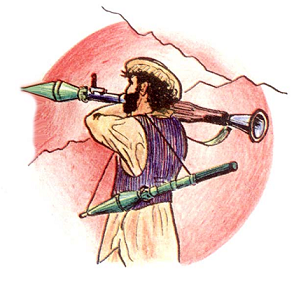And then there were three... (weekly review) By Vadim Borshchev, special to Prague Watchdog
Recently Ramzan Kadyrov has been painting the image of the enemy in terms that are contradictory and changeable, but interesting none the less. A highlight of the information on the life and work of the mujahedin which Chechnya’s head generously shared with us last week was the sensational news of a sharp reduction in the enemy’s numbers. While earlier Kadyrov had counted 70 warriors in the ranks of the insurgents, on Saturday June 27 that figure was radically altered. On the territory of the republic, according to its leader, "the problem of the liquidation of the illegal armed formations has practically been solved. Only some two dozen fighters remain in the hills." As to where the other 50 had “evaporated" to, there was not a word.
The new calculations appear to be based more on Kadyrov’s faith in the magical power of arithmetic than on data from the field. However, despite its sensational character this statement by the republic’s leader went unnoticed. It was not circulated in the news, either in the newspapers or on television. Reporters and journalists have long grown accustomed to Kadyrov’s easy – though now and then clumsy –way with words as he weaves them into the most unusual figures of speech. And the message these combinations convey have more to do with the speaker’s psychological condition than they have to do with reality.
As a matter of fact, Kadyrov’s tendency to substitute for the real enemy an artistic portrait executed in the tradition of the Soviet cartoon film manifests itself not only in his estimate of the numbers of the “shaytans” (Satans) he condemns. When talking about the small groups that shelter in the hills he regales his startled listeners with an apocalyptic picture of a multilingual Babylon that threatens Russia with destruction. Among the insurgents killed during special operations, he claims, are the representatives of countries which dream of reducing the Russian state to ash. "There are Azeris, Arabs, Turks, Ukrainians, Georgians,” etc.
Three days earlier, at a press conference in Magas on June 24, Kadyrov spoke of the insurgents’ high degree of preparation. This came as something of a surprise, as he is usually dismissive in his assessment of the quality of their fighting. Among them, he said, there were specialists in landmines and explosives, and these specialists were trained in all the skills of guerrilla warfare. In addition, they had at their disposal the most modern weapons, which the Russian army probably did not possess. Certain Western security services weree turning these men into unthinking fighting machines whose purpose was to destroy the territorial integrity of the Russian state.
In all of this one thing does not seem quite right, however. If the enemy are so cunning and ruthless, trained by the finest Western instructors and free of any problems concerning finance, why are there so few of them and why are they so pathetic? If in spite of their small numbers they are able to cause serious damage and constitute a threat to the whole of Russia, why is the head of the Chechen Republic so sure that he only needs a month in order to liquidate the entire armed underground?
In his handling of the logic of events Kadyrov is no less free and easy. It turns out that what the murder of Dagestan’s interior minister and the attempted assassination of the Ingush president show is not that the insurgents are growing stronger, but that they are suffering their death agonies. Realizing that their last hour has come, they are beginning to move about the mountain slopes in a manner that is reckless and erratic. Incidents like the attempted assassination bear witness to this panic. As Kadyrov put it: "The bandits sense that they have nowhere to hide and realize that their hours are numbered. We have stepped up our work against them, and they are running in the mountains and forests to save their skins."
Yet in Kadyrov’s description the enemy are not so simple and straightforward. Despite their neurotic tendencies and their small numbers, they still know how to fight and they have powerful support from abroad. This means that no matter how many of them are killed, as long as the will of the evil alien forces does not dry up, the trickle of agents of a hostile power will not dry up either. While it may not be hard to eliminate twenty men, where is the guarantee that the hostile special services will not train another twenty men and send them into the Chechen mountains to blow up more officials or assassinate them? And so it will go on, and on. It is obvious that serious thought now needs to be given to the elimination not of the rank and file insurgents but of the foreign centre itself, which dreams of the death of Russia.
(Translation by DM) (P,DM)
DISCUSSION FORUM
|

